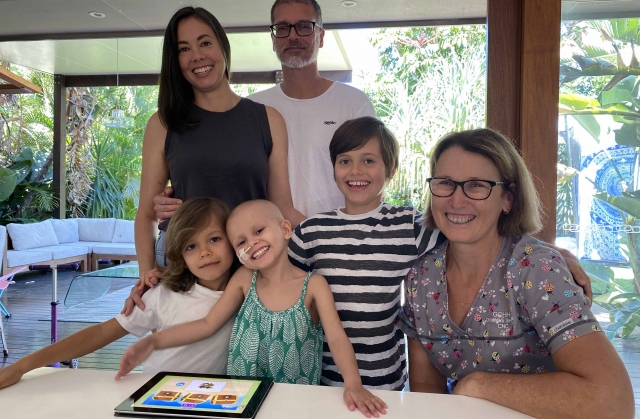Fluid bolus therapy in critically ill children: A survey of practice among paediatric intensive care doctors in Australia and New Zealand.

Maconachie, S., Jansen, M., Cottle, E., Roy, J., Ross, B., Winearls, J. and George, S., 2020. Viscoelastic haemostatic assays and fibrinogen in paediatric acute traumatic coagulopathy: A comprehensive review. Emergency Medicine Australasia

Gold Coast Health is delivering patient care in the comfort of home for paediatric patients who are at greater risk of infection, reducing hospital trips and anxiety during COVID-19.
Increasing the scope of care the Children’s Hospital in the Home (CHITH) service can provide during the pandemic has made the world of difference to immunocompromised patients undergoing cancer treatment like four-year-old Scout Pederson.
Prof Gerben Keijzers, A/Prof Shane George, Dr Stuart Watkins, Mr Michael Summers
Children frequently present to the emergency department with forearm injuries and often have an x-ray to assess if there is a fracture. Bedside ultrasound is a test that emergency practitioners can use to rapidly diagnose a fracture at the time of examination, without exposing children to ionising radiation. This trial will assess whether an x-ray is unnecessary when there is either a buckle fracture or no fracture seen on a portable ultrasound machine. We will also determine the time and cost implications of this new approach, which could enable families to go home earlier and could be more cost-effective, with less x-rays being ordered.
Franklin, D., Shellshear, D., Babl, F.E., Schlapbach, L.J., Oakley, E., Borland, M.L., Hoeppner, T., George, S., Craig, S., Neutze, J. and Williams, A., 2019. Multicentre, randomised trial to investigate early nasal high—flow therapy in paediatric acute hypoxaemic respiratory failure: a protocol for a randomised controlled trial—a Paediatric Acute respiratory Intervention Study (PARIS 2). BMJ open, 9(12).
Inserting a cannula (plastic tube) into a child's vein is a common procedure performed in the Emergency Department. This can be challenging and can cause considerable distress for the child and caregiver. The use of ultrasound is well established for guiding cannulas into veins of adults who are recognised as having difficult access. However, it is less commonly used in children for this purpose. By conducting this trial, we aim to identify factors that influence the success of cannula insertion into veins of children, particularly the early identification of patients with potentially difficult access, and any factors that influence the longevity of cannulas.
Dalziel, S.R., Borland, M.L., Furyk, J., Bonisch, M., Neutze, J., Donath, S., Francis, K.L., Sharpe, C., Harvey, A.S., Davidson, A., Craig, S., Phillips, N., George, S., Rao, R., Cheng, N., Zhang, M., Kochar, A., Brabyn, C., and Babl, F. 2019. Levetiracetam versus phenytoin for second-line treatment of convulsive status epilepticus in children (ConSEPT): an open-label, multicentre, randomised controlled trial. The Lancet, 393(10186), pp.2135-2145.
Dalziel, S.R., Borland, M.L., Furyk, J., Bonisch, M., Neutze, J., Donath, S., Francis, K.L., Sharpe, C., Harvey, A.S., Davidson, A., Craig, S., Phillips, N., George, S., Rao, R., Cheng, N., Zhang, M., Kochar, A., Brabyn, C., and Babl, F. 2019. Levetiracetam versus phenytoin for second-line treatment of convulsive status epilepticus in children (ConSEPT): an open-label, multicentre, randomised controlled trial. The Lancet, 393(10186), pp.2135-2145.
George, S., Humphreys, S., Williams, T., Gelbart, B., Chavan, A., Rasmussen, K., Ganeshalingham, A., Erickson, S., Ganu, S.S., Singhal, N. and Foster, K., 2019. Transnasal Humidified Rapid Insufflation Ventilatory Exchange in children requiring emerg2ent intubation (Kids THRIVE): a protocol for a randomised controlled trial. BMJ open, 9(2), p.e025997.
Bronchiolitis, a lower respiratory tract infection which causes inflammation of the small airways in infants, imposes the largest health care burden on hospital admissions worldwide, with up to 15 % of admissions to intensive care.
Nasal High Flow (NHF) therapy has emerged as a new method to support the breathing of these infants avoiding intensive care admission. We have shown in a previous large study that NHF therapy can be used in regional and metropolitan hospitals and reduces the need to transfer infants to a specialised children’s hospital. This new project entails working with six of the regional Queensland hospitals from the previous study to explore the optimal way to translate the new knowledge into practice.
We will compare three sites provided with structured educational support to three sites with no additional educational support. We suspect that the centres receiving the additional support will retain the knowledge and skill level to maintain and sustain optimal improved outcomes and have better uptake and adherence to evidence based NHF therapy guidelines for admitted infants with bronchiolitis.